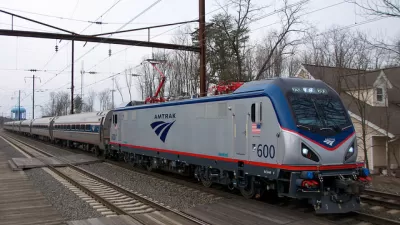A plan to get a SEPTA Regional Rail link to Phoenixville in record time has its skeptics, but advocates are convinced they can make it happen.

Phoenixville is a Pennsylvania Rust Belt town that bounced back from deindustrialization and today is home to craft breweries and mixed-use development. Now it wants to give itself a boost by connecting the town to SEPTA Regional Rail service.
A new proposal outlines a plan to get service up and running within 18 months of stakeholders agreeing to move forward. Jim Saksa explains that kind of schedule for a transportation project is unusual:
That would be nothing short of revolutionary in the world of public infrastructure, where projects are planned decades in advance and costs often grow like boa constrictors let loose in the Everglades, swelling to terrifying dimensions and strangling all they run across.
The pilot project calls for using Norfolk Southern freight tracks to connect Phoenixville to an existing SEPTA line. The projected cost for three barebones stations—just parking lots and platforms—and infrastructure upgrades is $15 million, with another $3 million a year to run the trains.
Critics of the plan say the cost estimates for building the stations and renting rails, rolling stock, and dual-mode locomotives are unrealistic. In addition, mixing freight and passenger service poses additional challenges.
Still the residents of Phoenixville are optimistic they can pull it off. "That’s an attitude born of Rust Belt rebirth -- the feeling that not all lost causes are lost, that through pluck and luck and some smalltown gumption, even the impossible is possible," observes Saksa.
FULL STORY: A long-shot plan to extend Regional Rail to Phoenixville could revolutionize how infrastructure is built

Alabama: Trump Terminates Settlements for Black Communities Harmed By Raw Sewage
Trump deemed the landmark civil rights agreement “illegal DEI and environmental justice policy.”

Study: Maui’s Plan to Convert Vacation Rentals to Long-Term Housing Could Cause Nearly $1 Billion Economic Loss
The plan would reduce visitor accommodation by 25% resulting in 1,900 jobs lost.

Why Should We Subsidize Public Transportation?
Many public transit agencies face financial stress due to rising costs, declining fare revenue, and declining subsidies. Transit advocates must provide a strong business case for increasing public transit funding.

Paris Bike Boom Leads to Steep Drop in Air Pollution
The French city’s air quality has improved dramatically in the past 20 years, coinciding with a growth in cycling.

Why Housing Costs More to Build in California Than in Texas
Hard costs like labor and materials combined with ‘soft’ costs such as permitting make building in the San Francisco Bay Area almost three times as costly as in Texas cities.

San Diego County Sees a Rise in Urban Coyotes
San Diego County experiences a rise in urban coyotes, as sightings become prevalent throughout its urban neighbourhoods and surrounding areas.
Urban Design for Planners 1: Software Tools
This six-course series explores essential urban design concepts using open source software and equips planners with the tools they need to participate fully in the urban design process.
Planning for Universal Design
Learn the tools for implementing Universal Design in planning regulations.
Smith Gee Studio
Alamo Area Metropolitan Planning Organization
City of Santa Clarita
Institute for Housing and Urban Development Studies (IHS)
City of Grandview
Harvard GSD Executive Education
Toledo-Lucas County Plan Commissions
Salt Lake City
NYU Wagner Graduate School of Public Service




























